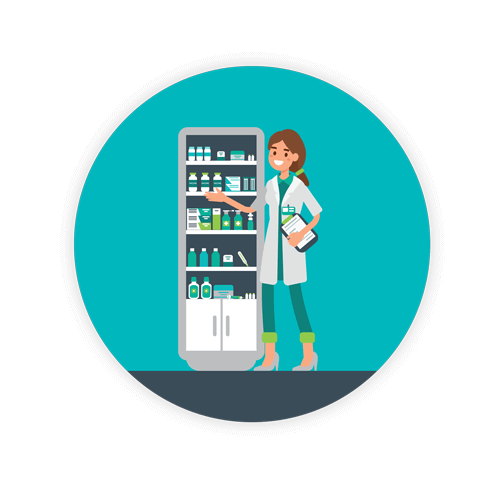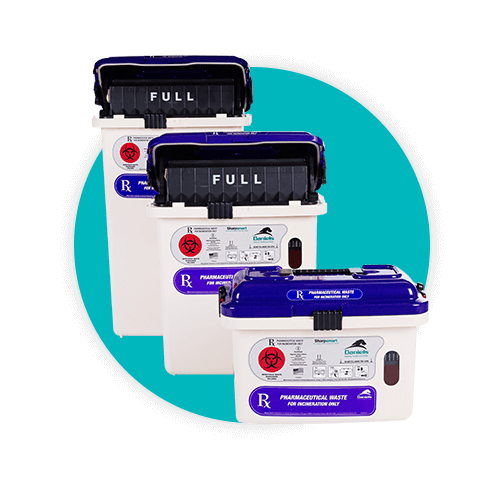Pharmaceutical Disposal: Are You Compliant?

When it comes to healthcare waste segregation and disposal, compliance with federal and state (and even local ordinances) is essential. Afterall, your reputation and your financial stability depend on it. Pharmaceutical waste disposal that is deemed to be non-compliant can cost your facility up to $70,000 per day, per violation.
That’s right. Fines and penalties for non-compliant disposal of pharmaceuticals are no joke. Are you still flushing unused prescription drugs down the toilet? You’d better not be. Recently, the Environmental Protection Agency (EPA) published their Final Rule, otherwise known as “Management Standards for Hazardous Waste Pharmaceuticals” that – unless exempt – is no longer permitted.
Why the change? Mainly to protect our water supplies. In the past, it’s been ‘okay’ for many facilities to flush unused drugs down toilets or drains. However, over the years, traces of a huge number of prescription drugs of all kinds have found their way into our city water sources and rivers, streams and lakes around the country. Water treatment plants are not designed to filter out all the impurities in our drinking water. In a nutshell, that’s why the new rule was implemented.
Yes, Daniels Health knows that new rules and regulations are always popping up, but we also understand how important it is to stay abreast of them. In addition to more environmentally friendly processes for pharmaceutical waste disposal, this Final Rule by the EPA attempts to also eliminate overlapping regulations between the EPA, the Food and Drug Administration (FDA), and the Drug Enforcement Administration (DEA).
What drugs are included in the Final Rule?
Among the important bits of information in this Final Rule is the elimination of dumping hazardous waste pharmaceuticals into the sewer either by flushing or washing down drains. Pharmaceuticals defined as hazardous waste are included in this prohibition:
- Prescription drugs
- Compounded drugs
- Over-the-counter drugs
- Homeopathic drugs
- Dietary supplements
- A drug that remains in a non-empty container
The EPA and the Resource Conservation and Recovery Act (RCRA) have listed a number of pharmaceuticals that are regulated as hazardous waste. This rule also covers new regulations for hazardous waste pharmaceuticals and their management by not only healthcare facilities, but reverse distributors.
Another part of the rule buttresses policies of RCRA legislation regarding healthcare facilities sending unsalable or unused prescription pharmaceuticals defined as hazardous waste to reverse distributors for manufacture credit. The Final Rule has designed more flexibility in this practice.
What do the new regulations say?
The primary component in the new law is the prohibition of flushing or washing hazardous-waste pharmaceuticals down drains. It also continues to encourage proper disposal of household hazardous waste exemptions for pharmaceuticals collected by takeback programs in local communities.
Standards under this new become effective on August 21, 2019.
Daniels Health recommends every healthcare provider involved with any type of pharmaceutical waste read the published document, a copy of which can be found in the Federal Register (the Daily Journal of the United States government) of the National Archives under 80 FR 5816. The document covers a number of topics that include:
- Rationale for the Final Rule
- Final Rule provisions
- EPA’s proposed regulations for reverse distribution of pharmaceuticals
- Applicability of the household hazardous waste exemption to retail items
- What facilities are subject to the Final Rule?
- What facilities are not subject to the Final Rule?
- Scope of hazardous wastes addressed by the Final Rule
A number of definitions are also included in the Final Rule under §266.500 including the definition of pharmaceuticals, hazardous waste pharmaceuticals, reverse distributors, and household waste pharmaceuticals among others.
In addition to the new Final Rule, healthcare facilities and medical providers must also adhere to federal, state, and local regulations regarding pharmaceutical waste disposal. Pharmaceutical waste management is just one part of overall healthcare waste management. It starts with healthcare waste segregation.
Pharmaceutical Waste Management is a Must!
It is estimated that less than 10% of pharmaceutical drugs are classified as hazardous waste. This is why it’s so important for healthcare providers and facilities to understand the classifications of the EPA’s hazardous-waste categories. It doesn’t matter whether you’re a pharmaceutical company, a manufacturer, hospital, or an outpatient clinic.
How do you know if a pharmaceutical drug is deemed hazardous waste? The EPA suggests you ask yourself four questions:
- Is it a listed waste? The EPA has a specific list of drugs that are deemed hazardous waste. These lists (F, K, P, and U) are further defined under Title 40 CFR §261.
- Is it a solid waste? Pharmaceutical drugs come in a variety of forms: solid, gels, pills, liquids, and so forth. A pill or capsule is considered a solid, so if it’s thrown away, it’s considered a solid waste.
- Does the drug qualify for an exemption? In most cases, pharmaceutical drugs don’t qualify for the majority of exclusions to the rule, which are very specific.
- Is it a “characteristic” waste? According to the Code of Federal Regulations (40 CFR 261), waste can be deemed hazardous if it includes a number of properties including: toxic, reactive, corrosive, or ignitable.
Some of the most common pharmaceutical drugs on the hazardous drug listings are those found under the “P” listing, such as:
- Warfarin
- Epinephrine
- Phentermine
- Nitroglycerin
- Physostigmine salicylate
- Physostigmine
Healthcare facilities should also be aware that a drug package can be considered hazardous waste if it contained any P or U listed chemicals – and if they’re not empty. The determination of “empty” is specifically defined under each of the classification lists for pharmaceuticals.
Pharmaceutical waste disposal occurs in steps
The importance of healthcare waste segregation, including processes involving pharmaceutical waste disposal is not to be underestimated. A number of factors are involved in compliant disposal or pharmaceutical wastes, including the amount of hazardous waste that your facility generates as well as the parameters of not only federal and state guidelines, but regulations of the county and even city ordinances.
Before pharmaceutical waste leaves a healthcare facility, it must be segregated into containers that meet the regulations of the Department of Transportation (DOT). A manifest (hazardous waste) must also be prepared to go along with the shipment. Appropriate types of placements of placards for vehicles transporting hazardous waste must also be observed.
The Code of Federal Regulations defines instructions for the transportation of hazardous waste including but not limited to 49 CFR Part 172 as well as instructions for labeling, sealing, and transportation.
Daniels Health encourages the cradle-to-grave approach for pharmaceutical waste disposal
Daniels Health provides support and resources to healthcare facilities of all sizes throughout the country. We firmly believe in healthcare facilities taking the cradle-to-grave approach, meaning that all healthcare facilities are responsible for the proper segregation, storage, labeling, and transportation of any pharmaceutical waste and other types of medical waste. Aside from being a highly ethical and moral approach to healthcare waste management – it’s also the law.
When it comes to medical waste removal, waste segregation, or compliant hazardous waste disposal methods, do it right – is not only your obligation, but will save you tens of thousands of dollars in fines and penalties.
For more information about Daniels Health and what we can do for you and your facility in addition to saving you money, providing reusable containers, and reducing container related sharps injuries, call us today. We’re here to help you save money and stay compliant.
Let's Talk!
Your time is valuable, and we don’t want to play hard to get. You can either phone us directly on the details listed on our contact page, or feel free to fill out this short form and one of our team members will get back to you as quickly as possible.
